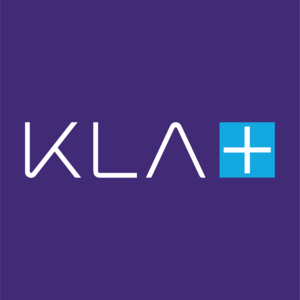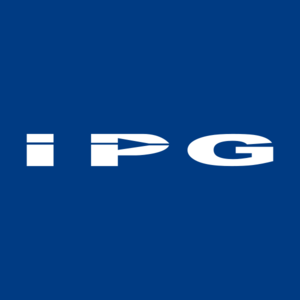
Photronics (PLAB)
Photronics piques our interest. Despite its slow anticipated growth, its extremely profitable operations give it a high margin of safety.― StockStory Analyst Team
1. News
2. Summary
Why Photronics Is Interesting
Sporting a global footprint of facilities, Photronics (NASDAQ:PLAB) is a manufacturer of photomasks, templates used to transfer patterns onto semiconductor wafers.
- Earnings growth has beaten its peers over the last five years as its EPS has compounded at 30.8% annually
- Excellent operating margin highlights the strength of its business model, and it turbocharged its profits by achieving some fixed cost leverage
- One pitfall is its gross margin of 35.9% reflects its high production costs


Photronics is close to becoming a high-quality business. If you like the story, the valuation looks reasonable.
Why Is Now The Time To Buy Photronics?
High Quality
Investable
Underperform
Why Is Now The Time To Buy Photronics?
At $34.05 per share, Photronics trades at 16.2x forward P/E. This multiple is lower than most semiconductor companies, and we think the valuation is reasonable for the quality you get.
If you think the market is not giving the company enough credit for its fundamentals, now could be a good time to invest.
3. Photronics (PLAB) Research Report: Q3 CY2025 Update
Semiconductor photomask manufacturer Photronics (NASDAQ:PLAB) announced better-than-expected revenue in Q3 CY2025, but sales fell by 3.1% year on year to $215.8 million. On top of that, next quarter’s revenue guidance ($221 million at the midpoint) was surprisingly good and 6.7% above what analysts were expecting. Its non-GAAP profit of $0.60 per share was 34.8% above analysts’ consensus estimates.
Photronics (PLAB) Q3 CY2025 Highlights:
- Revenue: $215.8 million vs analyst estimates of $204.5 million (3.1% year-on-year decline, 5.5% beat)
- Adjusted EPS: $0.60 vs analyst estimates of $0.45 (34.8% beat)
- Adjusted EBITDA: $73.86 million vs analyst estimates of $64.2 million (34.2% margin, 15.1% beat)
- Revenue Guidance for Q4 CY2025 is $221 million at the midpoint, above analyst estimates of $207 million
- Adjusted EPS guidance for Q4 CY2025 is $0.55 at the midpoint, above analyst estimates of $0.45
- Operating Margin: 24.1%, in line with the same quarter last year
- Free Cash Flow Margin: 9.4%, down from 11.3% in the same quarter last year
- Inventory Days Outstanding: 40, down from 41 in the previous quarter
- Market Capitalization: $1.52 billion
Company Overview
Sporting a global footprint of facilities, Photronics (NASDAQ:PLAB) is a manufacturer of photomasks, templates used to transfer patterns onto semiconductor wafers.
Photronics was founded in 1969 by Constantine S. MacRicostas, who was previously an engineering manager for semiconductor company Qualitron Corporation. Photronics went public in 1987 with a NASDAQ listing.
Semiconductor manufacturing begins with a silicon wafer upon which precise circuit patterns are transferred. This manipulation of thin layers of film results in conductor, semiconductor, or insulator properties on the wafer. It is a complex process requiring precision tools, specific temperatures at various stages, and ideal environments. Photomasks, which are quartz or glass plates containing microscopic images of electronic circuits, are a key precision tool for this transfer of circuit patterns onto silicon wafers.
Photronics’ customers are largely semiconductor foundries (manufacturers) as well as fabless semiconductor companies (designers who outsource manufacturing). The company manufactures photomasks that reflect circuit designs provided by these customers. The typical manufacturing process for a photomask first involves receiving circuit design data from the customer and converting these to manufacturing pattern data. Photronics’ lithography systems, which use electron beams and lasers, then etch the circuit patterns onto photomask blanks. Once the final products pass rigorous testing and assessments, they are shipped to the customer.
Photomask manufacturers that compete with Photonics include Compugraphics, Dai Nippon Printing (TSE:7912), Hoya Corporation (TSE:7741), LG Innotek (KOSE:A011070), and Shenzhen Newway Photomask (SHSE:688401).
4. Revenue Growth
A company’s long-term performance is an indicator of its overall quality. Any business can put up a good quarter or two, but the best consistently grow over the long haul. Luckily, Photronics’s sales grew at a decent 6.9% compounded annual growth rate over the last five years. Its growth was slightly above the average semiconductor company and shows its offerings resonate with customers. Semiconductors are a cyclical industry, and long-term investors should be prepared for periods of high growth followed by periods of revenue contractions.
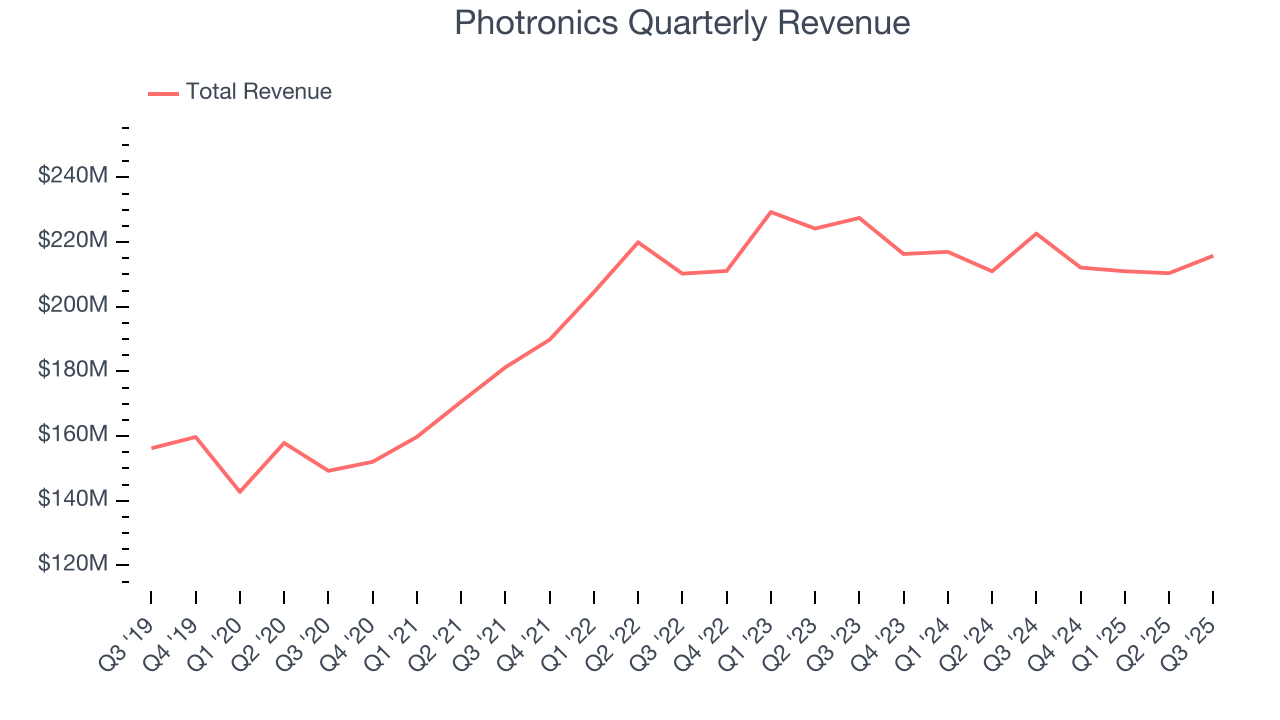
We at StockStory place the most emphasis on long-term growth, but within semiconductors, a half-decade historical view may miss new demand cycles or industry trends like AI. Photronics’s recent performance marks a sharp pivot from its five-year trend as its revenue has shown annualized declines of 2.4% over the last two years. 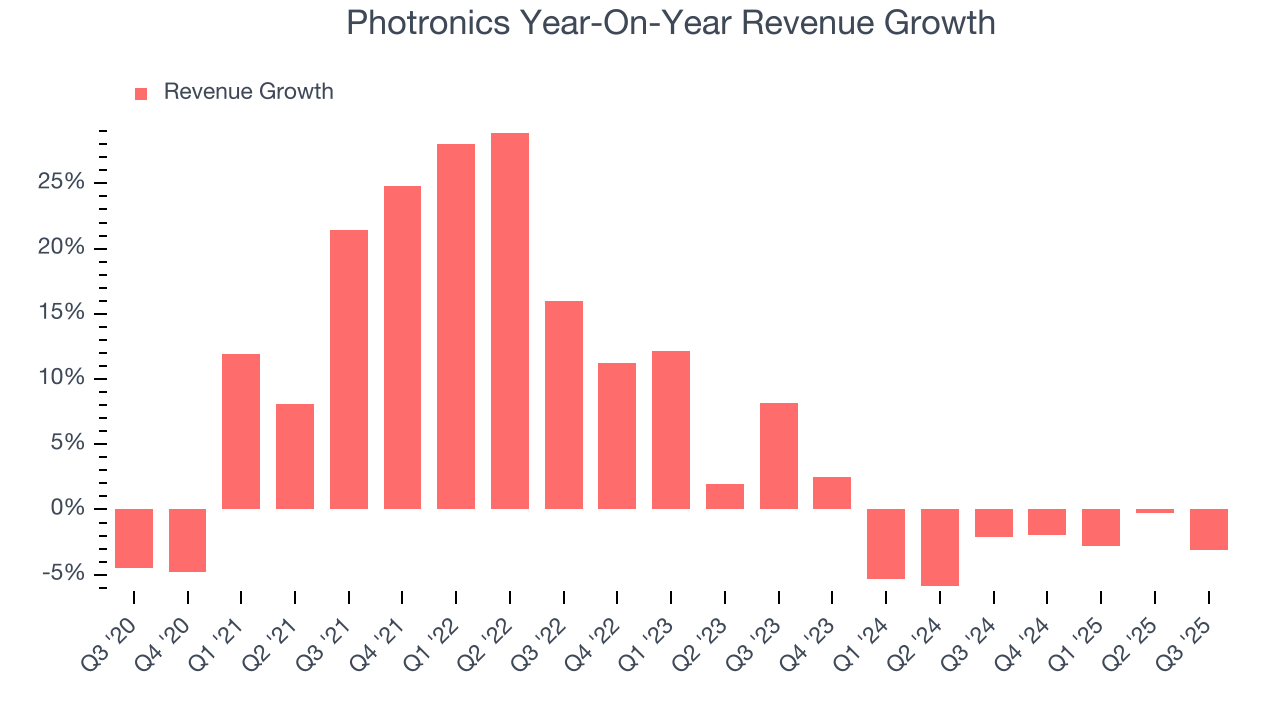
This quarter, Photronics’s revenue fell by 3.1% year on year to $215.8 million but beat Wall Street’s estimates by 5.5%. Despite the beat, the drop in sales could mean that the current downcycle is deepening. Company management is currently guiding for a 4.2% year-on-year increase in sales next quarter.
Looking further ahead, sell-side analysts expect revenue to grow 3.9% over the next 12 months. While this projection suggests its newer products and services will catalyze better top-line performance, it is still below average for the sector.
5. Product Demand & Outstanding Inventory
Days Inventory Outstanding (DIO) is an important metric for chipmakers, as it reflects a business’ capital intensity and the cyclical nature of semiconductor supply and demand. In a tight supply environment, inventories tend to be stable, allowing chipmakers to exert pricing power. Steadily increasing DIO can be a warning sign that demand is weak, and if inventories continue to rise, the company may have to downsize production.
This quarter, Photronics’s DIO came in at 40, which is 2 more days than its five-year average. These numbers suggest that despite the recent decrease, the company’s inventory levels are slightly above the long-term average.
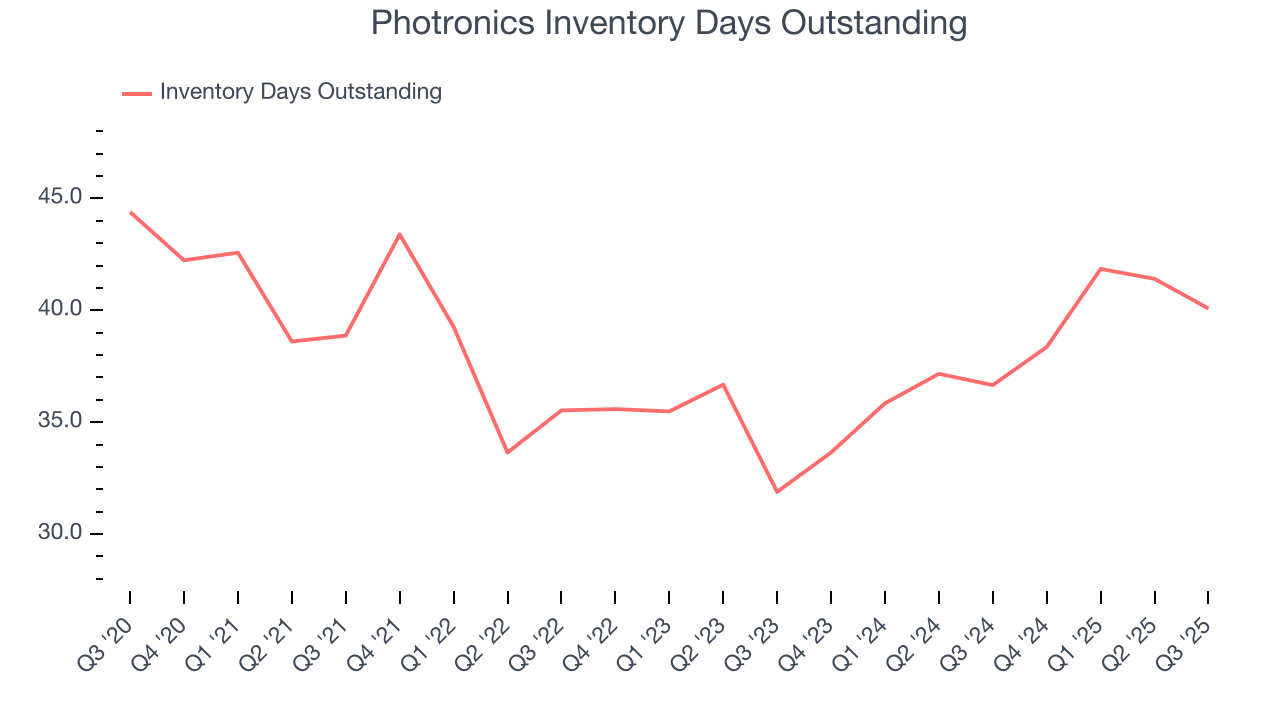
6. Gross Margin & Pricing Power
Gross profit margin is a key metric to track because it shows how much money a semiconductor company gets to keep after paying for its raw materials, manufacturing, and other input costs.
Photronics’s gross margin is one of the worst in the semiconductor industry, signaling it operates in a competitive market and lacks pricing power. As you can see below, it averaged a 35.9% gross margin over the last two years. That means Photronics paid its suppliers a lot of money ($64.12 for every $100 in revenue) to run its business. 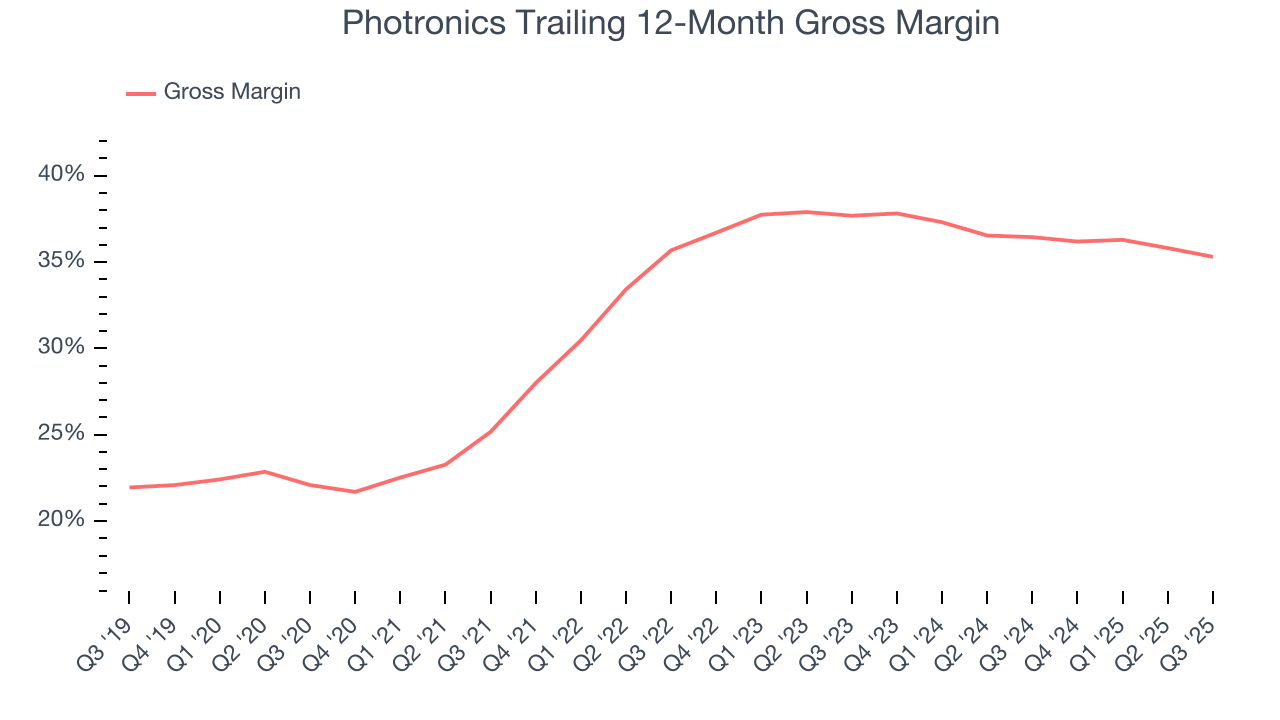
Photronics’s gross profit margin came in at 35% this quarter, marking a 2 percentage point decrease from 37% in the same quarter last year. Photronics’s full-year margin has also been trending down over the past 12 months, decreasing by 1.1 percentage points. If this move continues, it could suggest a more competitive environment with some pressure to lower prices and higher input costs (such as raw materials and manufacturing expenses).
7. Operating Margin
Operating margin is one of the best measures of profitability because it tells us how much money a company takes home after procuring and manufacturing its products, marketing and selling those products, and most importantly, keeping them relevant through research and development.
Photronics has been an efficient company over the last two years. It was one of the more profitable businesses in the semiconductor sector, boasting an average operating margin of 25%. This result was particularly impressive because of its low gross margin, which is mostly a factor of what it sells and takes huge shifts to move meaningfully. Companies have more control over their operating margins, and it’s a show of well-managed operations if they’re high when gross margins are low.
Looking at the trend in its profitability, Photronics’s operating margin rose by 10.8 percentage points over the last five years, as its sales growth gave it operating leverage.
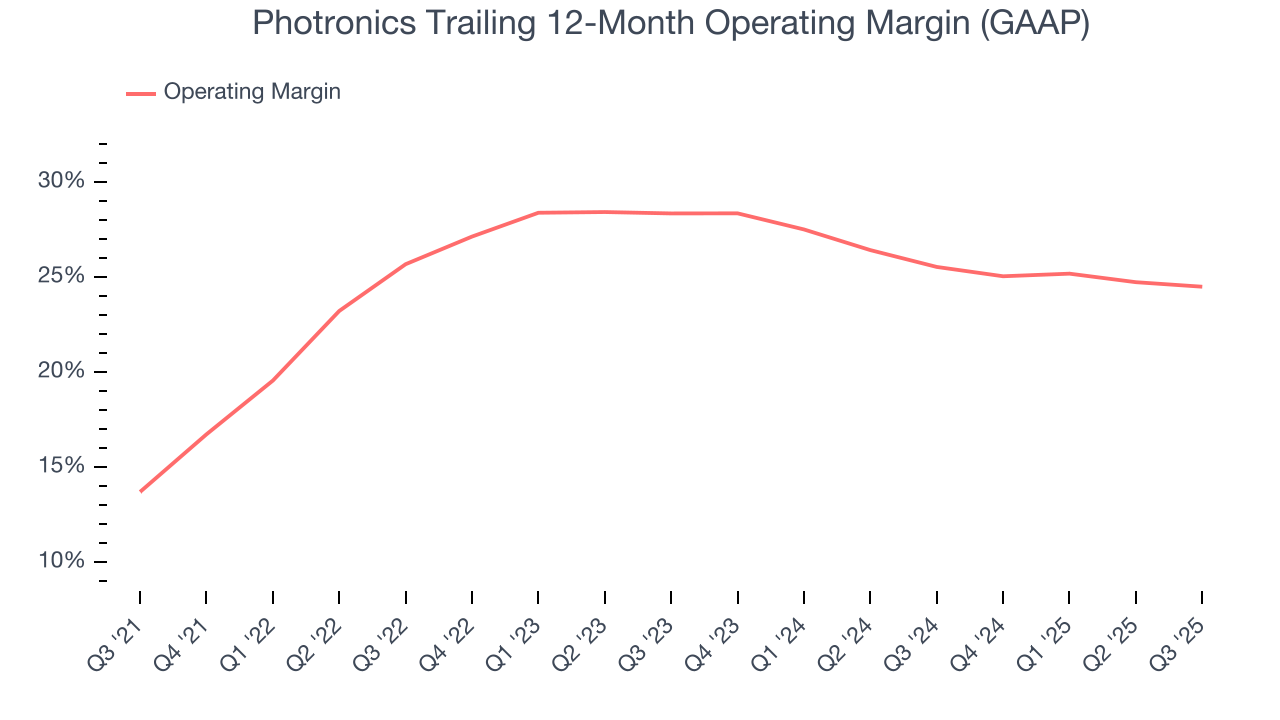
This quarter, Photronics generated an operating margin profit margin of 24.1%, in line with the same quarter last year. This indicates the company’s cost structure has recently been stable.
8. Earnings Per Share
We track the long-term change in earnings per share (EPS) for the same reason as long-term revenue growth. Compared to revenue, however, EPS highlights whether a company’s growth is profitable.
Photronics’s EPS grew at an astounding 30.8% compounded annual growth rate over the last five years, higher than its 6.9% annualized revenue growth. This tells us the company became more profitable on a per-share basis as it expanded.
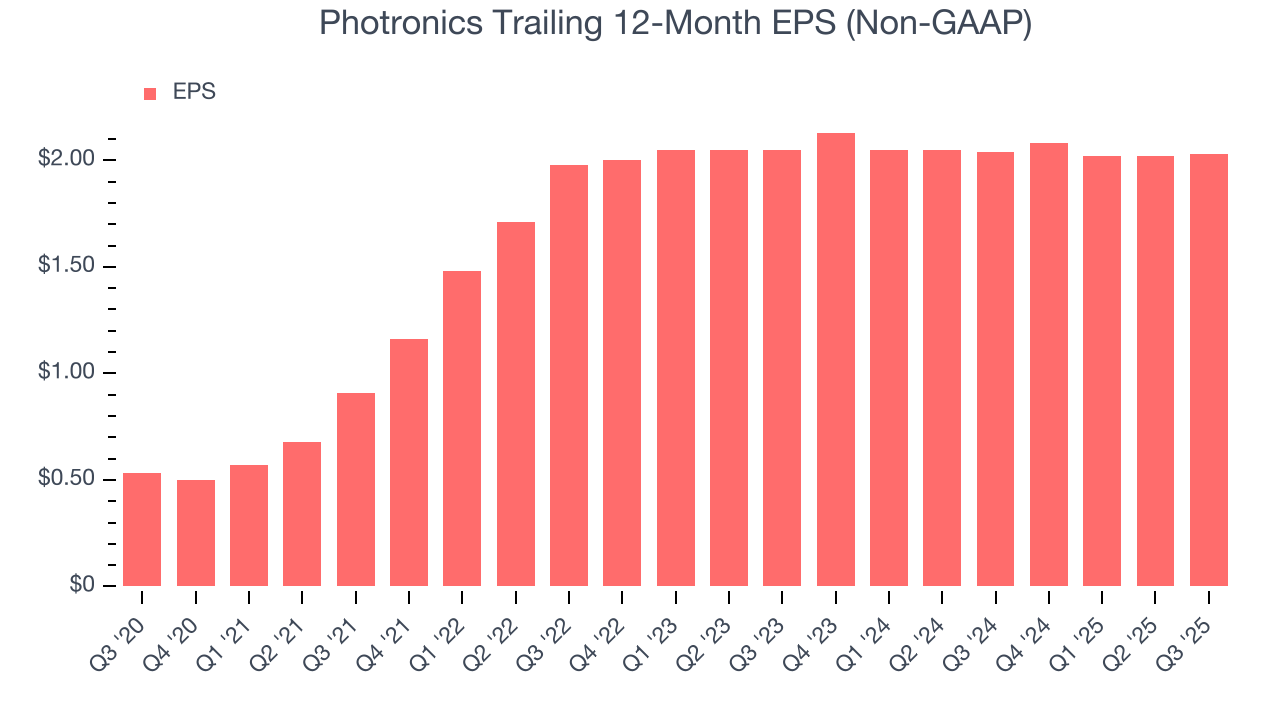
Diving into Photronics’s quality of earnings can give us a better understanding of its performance. As we mentioned earlier, Photronics’s operating margin was flat this quarter but expanded by 10.8 percentage points over the last five years. On top of that, its share count shrank by 10.5%. These are positive signs for shareholders because improving profitability and share buybacks turbocharge EPS growth relative to revenue growth.
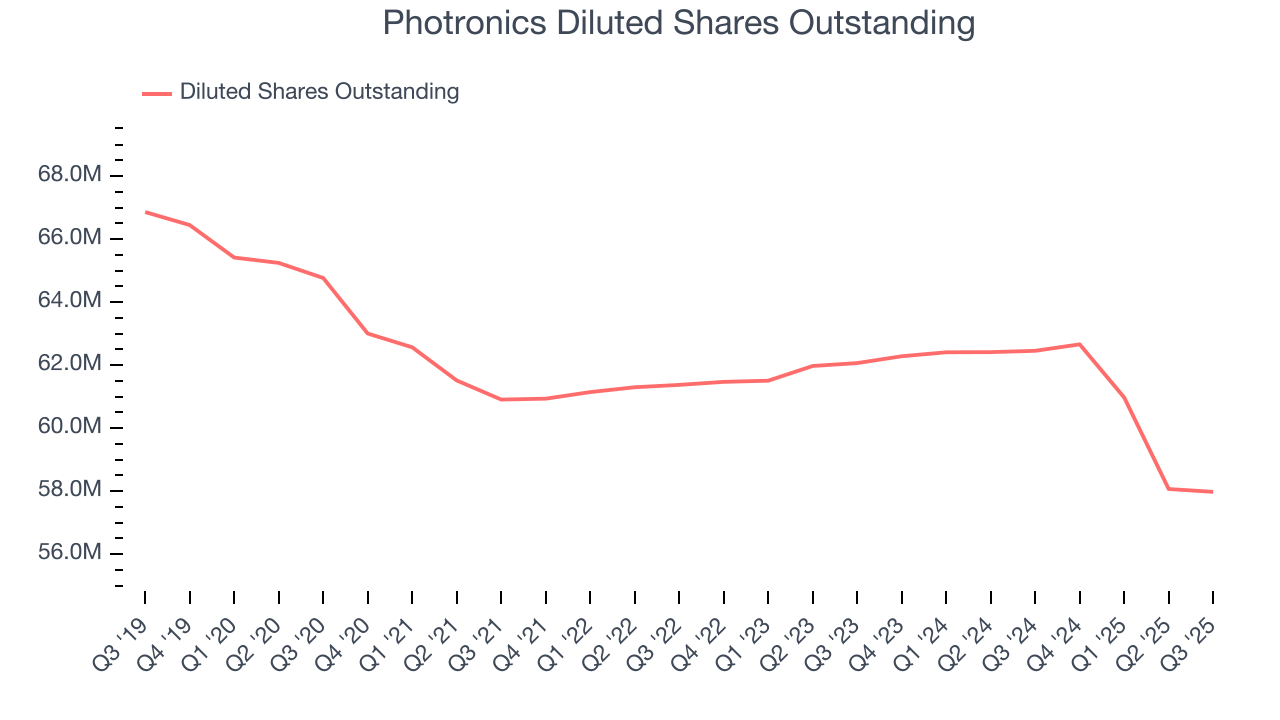
In Q3, Photronics reported adjusted EPS of $0.60, up from $0.59 in the same quarter last year. This print easily cleared analysts’ estimates, and shareholders should be content with the results. Over the next 12 months, Wall Street expects Photronics’s full-year EPS of $2.03 to stay about the same.
9. Cash Is King
Although earnings are undoubtedly valuable for assessing company performance, we believe cash is king because you can’t use accounting profits to pay the bills.
Photronics has shown weak cash profitability over the last two years, giving the company limited opportunities to return capital to shareholders. Its free cash flow margin averaged 11.1%, subpar for a semiconductor business. The divergence from its good operating margin stems from its capital-intensive business model, which requires Photronics to make large cash investments in working capital and capital expenditures.
Taking a step back, we can see that Photronics failed to improve its margin over the last five years. Its unexciting margin and trend likely have shareholders hoping for a change.
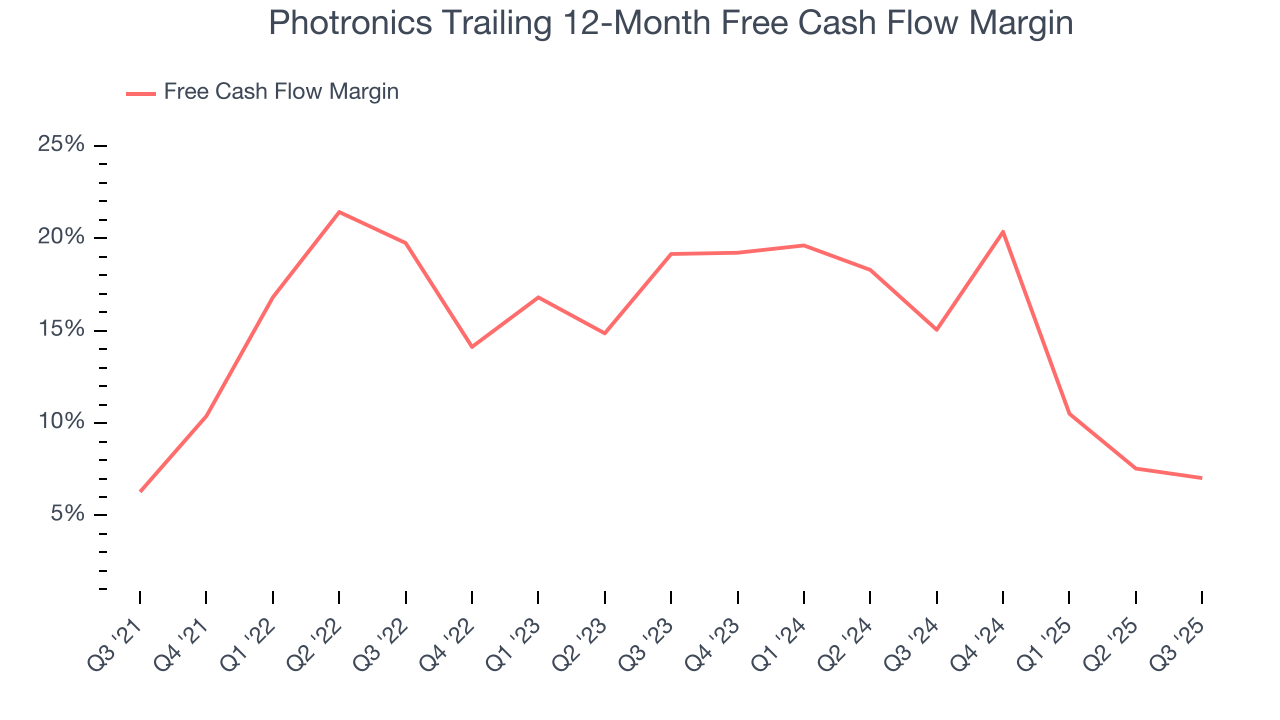
Photronics’s free cash flow clocked in at $20.28 million in Q3, equivalent to a 9.4% margin. The company’s cash profitability regressed as it was 1.9 percentage points lower than in the same quarter last year, prompting us to pay closer attention. Short-term fluctuations typically aren’t a big deal because investment needs can be seasonal, but we’ll be watching to see if the trend extrapolates into future quarters.
10. Return on Invested Capital (ROIC)
EPS and free cash flow tell us whether a company was profitable while growing its revenue. But was it capital-efficient? Enter ROIC, a metric showing how much operating profit a company generates relative to the money it has raised (debt and equity).
Although Photronics hasn’t been the highest-quality company lately, it historically found a few growth initiatives that worked. Its five-year average ROIC was 27.7%, higher than most semiconductor businesses.
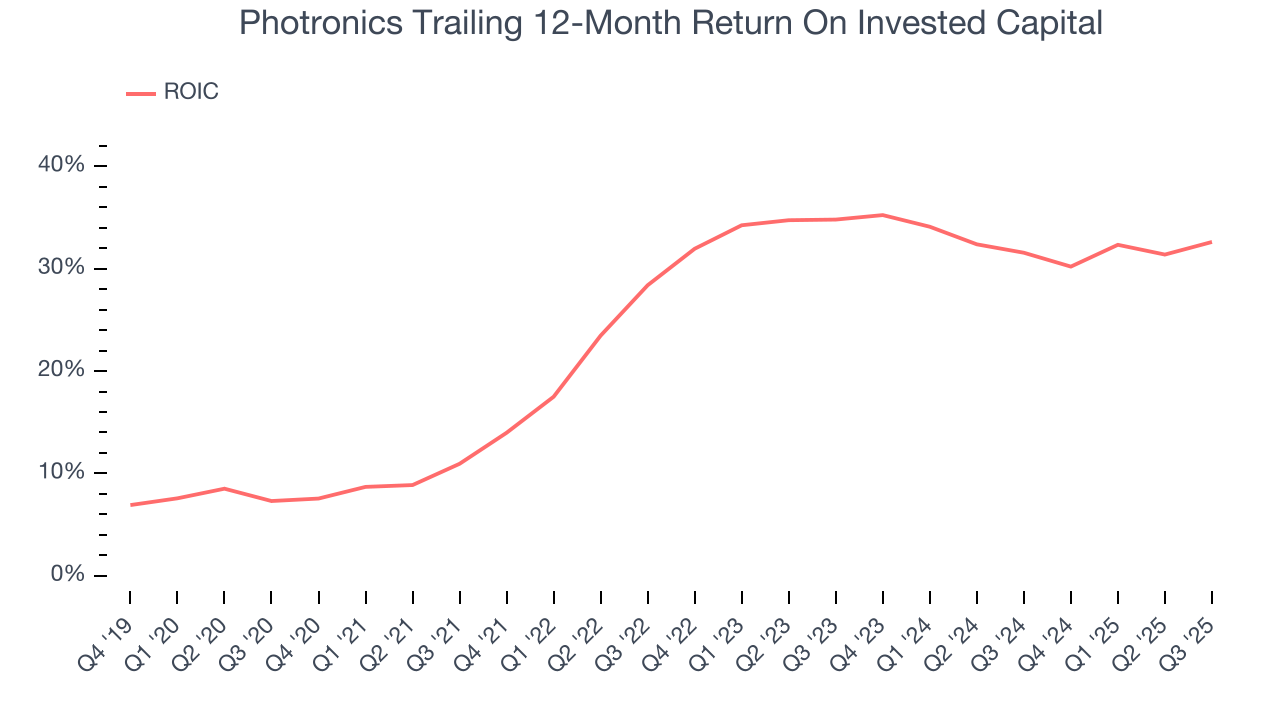
11. Balance Sheet Assessment
Businesses that maintain a cash surplus face reduced bankruptcy risk.
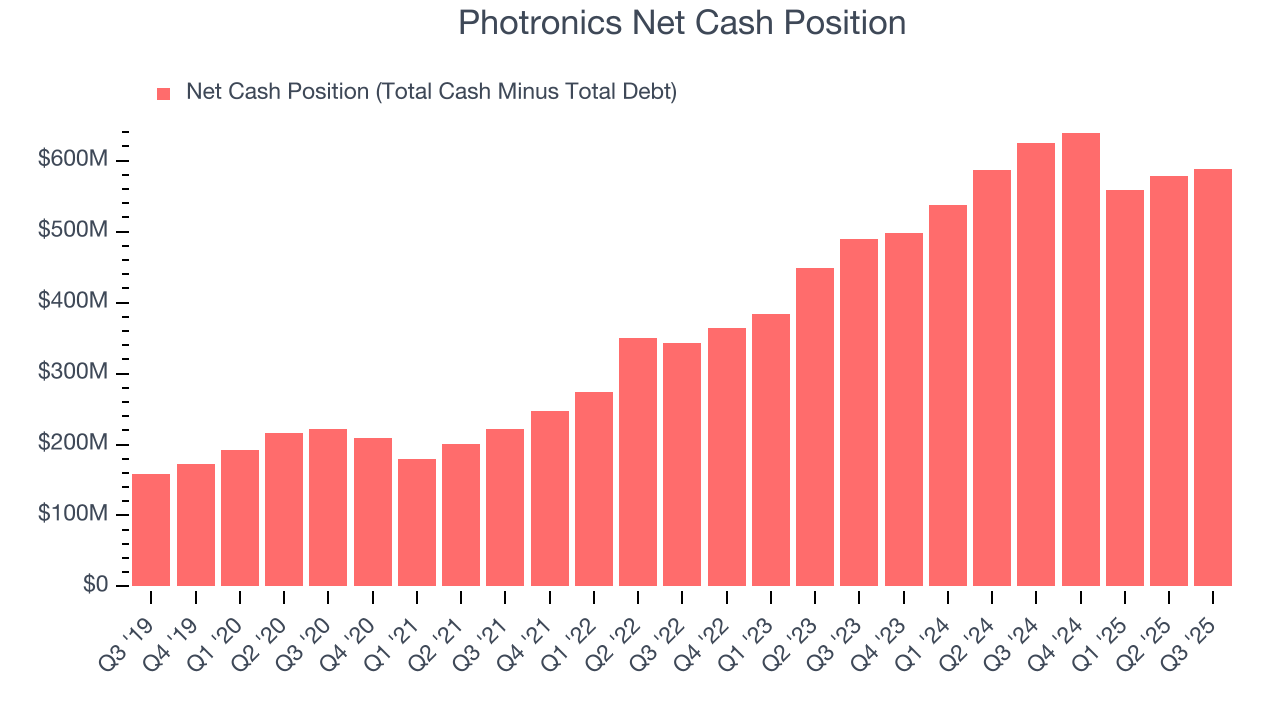
Photronics is a profitable, well-capitalized company with $588.2 million of cash and $24,000 of debt on its balance sheet. This $588.1 million net cash position is 38.8% of its market cap and gives it the freedom to borrow money, return capital to shareholders, or invest in growth initiatives. Leverage is not an issue here.
12. Key Takeaways from Photronics’s Q3 Results
It was good to see Photronics beat analysts’ EPS expectations this quarter. We were also glad its revenue guidance for next quarter exceeded Wall Street’s estimates. Zooming out, we think this quarter featured some important positives. The stock traded up 11.5% to $28.65 immediately after reporting.
13. Is Now The Time To Buy Photronics?
Updated: December 24, 2025 at 9:29 PM EST
When considering an investment in Photronics, investors should account for its valuation and business qualities as well as what’s happened in the latest quarter.
There are some positives when it comes to Photronics’s fundamentals. To begin with, the its revenue growth was decent over the last five years, and analysts believe it can continue growing at these levels. And while Photronics’s projected EPS for the next year is lacking, its astounding EPS growth over the last five years shows its profits are trickling down to shareholders.
Photronics’s P/E ratio based on the next 12 months is 16.2x. Looking at the semiconductor landscape right now, Photronics trades at a pretty interesting price. For those confident in the business and its management team, this is a good time to invest.
Wall Street analysts have a consensus one-year price target of $43.50 on the company (compared to the current share price of $34.05), implying they see 27.8% upside in buying Photronics in the short term.




